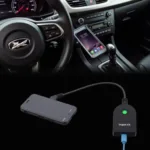An OBD2 relay switch is a small, but mighty component that plays a crucial role in your car’s electrical system. Just like a gatekeeper, it controls the flow of high-current electricity to various components, such as the starter motor, fuel pump, and headlights, ensuring their safe and efficient operation. Understanding how OBD2 relay switches function can be incredibly helpful when diagnosing electrical issues in your vehicle.
What Exactly is an OBD2 Relay Switch and How Does It Work?
Imagine trying to turn on a powerful floodlight with a tiny switch; it wouldn’t be able to handle the load. This is where the OBD2 relay switch steps in. It acts as an intermediary, taking a small electrical signal from your car’s computer (the OBD2 system) and using it to activate a separate high-current circuit. This allows components with large power demands to function properly without overloading the delicate circuitry of the OBD2 system.
Inside the relay switch, you’ll find an electromagnet and a set of electrical contacts. When the OBD2 system sends a signal, it activates the electromagnet, which in turn, pulls the contacts together, closing the high-current circuit. Once the signal is removed, the electromagnet deactivates, and the contacts open, breaking the circuit.
The Vital Role of OBD2 Relay Switches in Your Car
OBD2 relay switches are essential for:
- Protecting sensitive circuits: They prevent high-current surges from damaging the delicate electronic components in the OBD2 system.
- Controlling high-power devices: They enable the OBD2 system to manage components that require significant electrical power, such as the starter, ignition system, and fuel pump.
- Improving safety: They ensure that high-current circuits are only activated when needed, reducing the risk of electrical shorts and fires.
Identifying a Faulty OBD2 Relay Switch: Common Symptoms
When an OBD2 relay switch fails, it can cause a variety of problems, ranging from minor inconveniences to major malfunctions. Here are some common symptoms:
- Component failure: The most obvious sign is the complete failure of the component controlled by the relay, such as the starter motor or headlights not working.
- Intermittent issues: You may experience intermittent problems with the component, like flickering headlights or a starter motor that clicks but doesn’t crank.
- Clicking sounds: A clicking sound coming from the relay itself can indicate a failing electromagnet or contacts.
Troubleshooting and Replacing OBD2 Relay Switches
Diagnosing a faulty OBD2 relay switch often involves checking for continuity and voltage with a multimeter. You can also try swapping the suspect relay with a known good one from a similar circuit.
If you’re not comfortable working with electrical components, it’s best to consult a qualified mechanic. Replacing an OBD2 relay switch is usually a straightforward process, but it’s crucial to ensure the new relay has the correct specifications for your vehicle.
OBD2 Relay Switches: Keeping Your Car Running Smoothly
While seemingly small, OBD2 relay switches are vital components that keep your car running smoothly. Understanding their function and being able to recognize the signs of failure can save you time, money, and frustration on the road.
Remember, if you suspect an issue with your OBD2 relay switch or any other electrical component, it’s always best to seek professional help.

